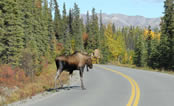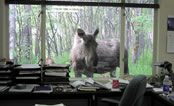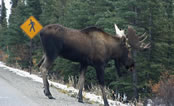Moose Safety
 Bull moose crossing road near Denali National Park. Photo by John Love, Alaska DOT&PF. |
 Moose inspecting DOT&PF Central Region Annex building, Anchorage. Photo by Joe Gibbons, Alaska DOT&PF. |
Moose are a common part of life for most Alaskans. These massive, hulking creatures wander through our sports fields, poke around our neighborhoods and nonchalantly cross our roads and highways, forcing some motorists to wait and others to crash.
Every year moose routinely cause injury-related traffic crashes throughout the interior of Alaska, resulting in millions of dollars in medical bills and property damage.
While moose are happy to pose for a picture or two it is important to give them lots of room, especially when calves are nearby. Generally they ignore people and human activities, and are more interested in food. Moose don't eat meat, but many Alaskan animals find moose to be tasty. They are a favorite of bears, wolves and humans. Each year, hunters harvest 6,000-8,000 Alaskan moose—that's 3.5 million pounds of lean meat. A single moose can feed a family of four all winter long.
In winter finding food is difficult, and moose flood the low areas, often taking refuge in cities. Anchorage's wintertime moose population can triple to just under 1,000. There, the moose live off the locals' landscaping efforts, eating mountain ash and birch trees. This also means that moose will be more likely to wander into the local roads and highways.
Safety Tips:
The Alaska Highway Safety Office offers the following tips to help avoid a deadly confrontation with moose:
- Never feed a moose
- Give moose at least 50 feet. If it doesn't yield as you approach, give it the trail.
- If a moose lays its ears back or its hackles (the hairs on its hump) rise, it's angry or afraid and may charge.
- Moose kick with their front as well as hind feet so we suggest not confronting them directly.
- Don't corner moose into fences or houses.
- If a moose charges, there are few options available to you but it has been suggested by many others to simply get behind a tree. A theory stands that you can run around the trunk faster than the gangly moose.
- Never get between a cow and her calf.
Statewide Organizations
Statistics
Safety Topics
- DEC / DRE
- Distracted Driving
- Fatality Analysis Reporting System (FARS)
- Headlights
- LEL - Law Enforcement Liaisons
- Low Speed Vehicles
- Media Campaigns
- Mock Crashes
- Moose Safety
- Occupant Protection
- REDDI
- Safe Communities
- DUI Information & Impaired Driving
- Safety Corridor
- Senior Driving in Alaska
- Teen Driving in Alaska
- Snowmobiles and ATVs
- Traffic Records
Please note: You must have Acrobat Reader to open any ![]() documents on this page. If you do not have Acrobat Reader, click to download the FREE software.
documents on this page. If you do not have Acrobat Reader, click to download the FREE software.

